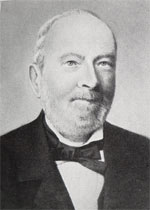Related Research Articles

Elmer Ambrose Sperry Sr. was an American inventor and entrepreneur, most famous as co-inventor, with Herman Anschütz-Kaempfe, of the gyrocompass and as founder of the Sperry Gyroscope Company. He was known as the "father of modern navigation technology."

SMS Dresden was a German light cruiser built for the Kaiserliche Marine, the lead ship of her class. She was laid down at the Blohm & Voss shipyard in Hamburg in 1906, launched in October 1907, and completed in November 1908. Her entrance into service was delayed by accidents during sea trials, including a collision with another vessel that necessitated major repairs. Like the preceding Königsberg-class cruisers upon which her design was based, Dresden was armed with ten 10.5 cm (4.1 in) SK L/40 guns and two torpedo tubes.

Arthur Peter König devoted his short life to physiological optics. Born with congenital kyphosis he studied in Bonn and Heidelberg, moving to Berlin in the fall of 1879 where he studied under Hermann von Helmholtz, whose assistant he became in 1882. After obtaining a doctoral degree in 1882 he qualified for a professorial position in 1884. In 1890 he became director of the physical department of the Physiological Institute of the University of Berlin. In the same year he married Laura Köttgen with whom he had a son, Arthur, who became an astronomer. Circulatory problems caused by his kyphosis resulted in his premature death in 1901.

Prince Albert William Henry of Prussia was a younger brother of German Emperor William II and a Prince of Prussia. He was also a grandson of Queen Victoria. A career naval officer, he held various commands in the Imperial German Navy, eventually rose to the rank of Grand Admiral and Generalinspekteur der Marine.

Adolf Bernhard Meyer was a German anthropologist, ornithologist, entomologist, and herpetologist. He served for nearly thirty years as director of the Königlich Zoologisches und Anthropologisch-Ethnographisches Museum in Dresden. He worked on comparative anatomy and appreciated the ideas of evolution, and influenced many German scientists by translating into German the 1858 papers by Darwin and Wallace which first proposed evolution by natural selection. Influenced by the writings of Wallace with whom he interacted, he travelled to Southeast Asia, and collected specimens and recorded his observations from the region.
Wilhelm Heinrich Roscher was a German classical scholar. He specialized in studies of Greek and Roman mythology.

August Ferdinand Howaldt was a German engineer and ship builder. The German sculptor Georg Ferdinand Howaldt was his brother.

Fürchtegott Theodor Kirchner was a German composer and pianist of the Romantic era.

Carl Georg Oscar Drude was a German botanist.

Udo Zimmermann is a German composer, musicologist, opera director and conductor. He worked as a professor of composition, founded a centre for contemporary music in Dresden, and was director of the Leipzig Opera and the Deutsche Oper Berlin. He directed a contemporary music series for the Bayerischer Rundfunk and a European centre of the arts in Hellerau. His operas, especially Weiße Rose, on a topic he set to music twice, have been performed internationally and recorded.
Alfred Karl Gabriel Jeremias was a German pastor, Assyriologist and an expert on the religions of the Ancient Near East.
Hans Reimann (1889–1969) was a German satirist, novelist, and playwright. He wrote under the pseudonyms Max Bunge, Hans Heinrich, Artur Sünder, Hanns Heinz Vampir, and Andreas Zeltner.

Georg Christian Thilenius was a German physician and anthropologist who was a native of Soden am Taunus.
Goby Eberhardt was a German violinist, teacher and composer.
Reisehaandbog over Norge is a Norwegian travel guide book first published in 1879 by Yngvar Nielsen. It was re-issued in twelve different editions between 1879 and 1915. The guide book became quite popular, and played an important role in the development of tourism in Norway. An English edition of the guide book was published in 1886.

Friedrich August Wilhelm Baumfelder was a German composer of classical music, conductor, and pianist. He started in the Leipzig Conservatory, and went on to become a well-known composer of his time. His many works were mostly solo salon music, but also included symphonies, piano concertos, operas, and choral works. Though many publishers published his work, they have since fallen into obscurity.
Konrad Haebler was a German (Saxonian) librarian, historian and expert on incunabula.

Johann Gottfried Eduard Bayer, usually known as Eduard Bayer, was a German composer for the classical guitar and a virtuoso performer on the guitar, harp guitar, mandolin and zither.

Eduard Wunder (1800–1869) was a German philologist, and from 1843 to 1866 Rector of the Fürstenschule Grimma in Saxony.

Carl Franz Edmund Kretschmer was a German organist and composer who worked for the Dresden Court and composed several operas and masses.
References
- ↑ US patent for gyroscopic ship roll damper (1908)
- ↑ Tristan Perez, Ship Motion Control, Springer Verlag, Berlin/Heidelberg, 2005, ISBN 978-1-85233-959-3, p.123 ff
- ↑ Kreiselstabilisatoren in German Wikipedia entry on ship stabilisers